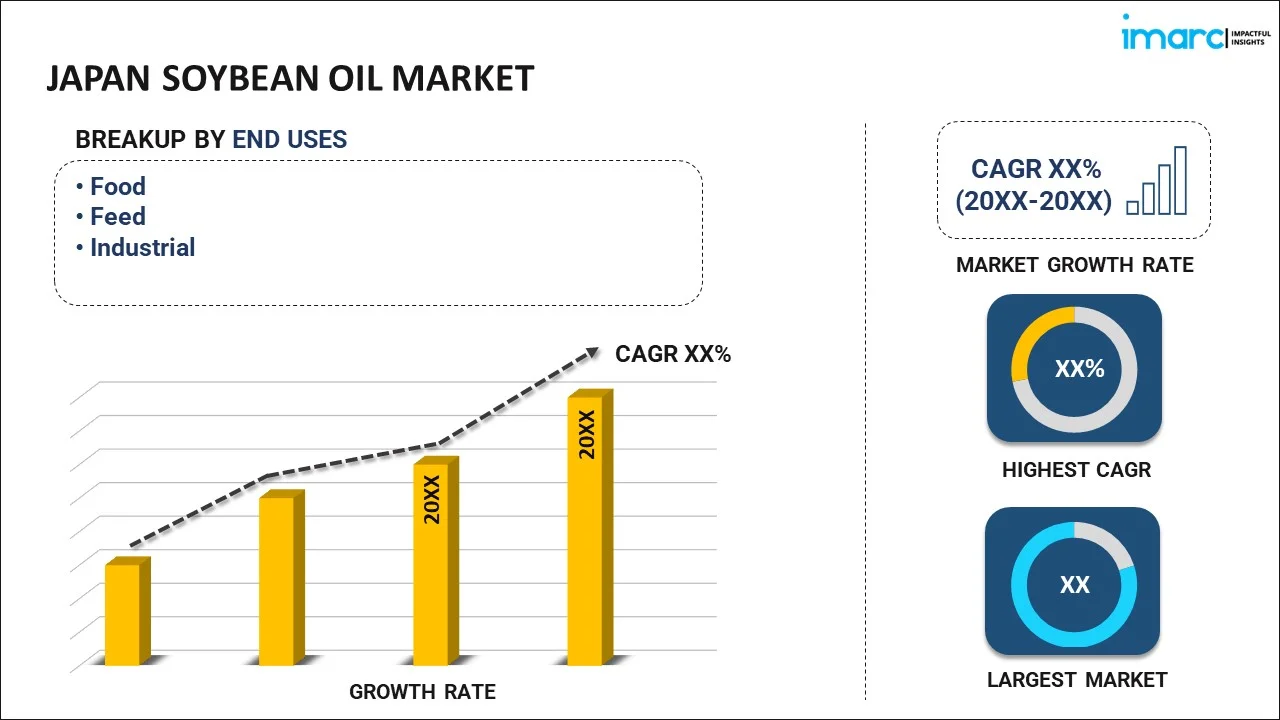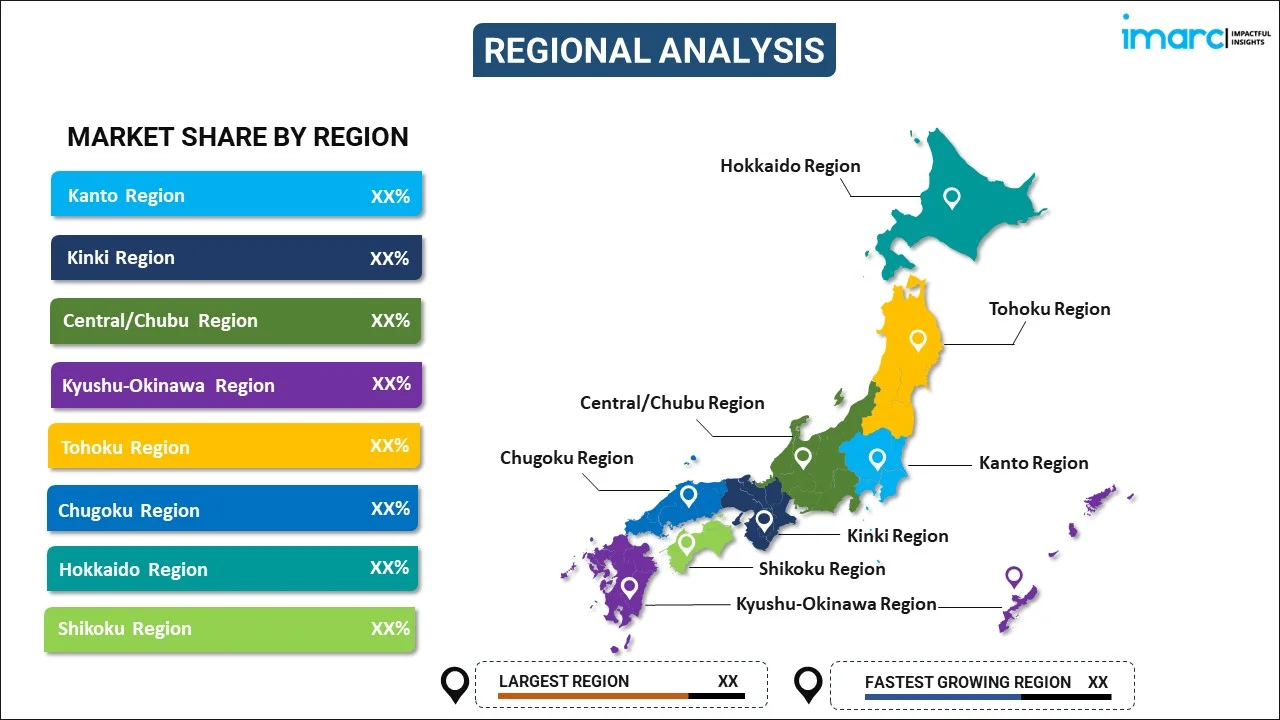
Japan Soybean Oil Market Report by End Use (Food, Feed, Industrial), and Region 2025-2033
Market Overview:
The Japan soybean oil market size reached 474.8 Thousand Tons in 2024. Looking forward, IMARC Group expects the market to reach 590.4 Thousand Tons by 2033, exhibiting a growth rate (CAGR) of 2.3% during 2025-2033. The increasing demand for edible oil, the rising health consciousness among consumers, the growing shift to plant-based diets, and the inflating disposable incomes of consumers represent some of the key factors driving the market.
|
Report Attribute
|
Key Statistics
|
|---|---|
|
Base Year
|
2024
|
|
Forecast Years
|
2025-2033
|
|
Historical Years
|
2019-2024
|
|
Market Size in 2024
|
474.8 Thousand Tons |
|
Market Forecast in 2033
|
590.4 Thousand Tons |
| Market Growth Rate 2025-2033 | 2.3% |
Soybean oil is a versatile and widely used vegetable oil derived from soybeans. Its light flavor and high smoke point make it a popular choice for cooking, baking, and frying. The oil is extracted by cleaning, dehulling, and crushing the soybeans, followed by pressing and refining to remove impurities. One of the key advantages of soybean oil is its balanced fatty acid profile, consisting of polyunsaturated, monounsaturated, and saturated fats. It contains a significant amount of omega-6 fatty acids, which are essential for the body but should be consumed in moderation to maintain a healthy balance with omega-3 fatty acids. It is also a good source of vitamin E, an antioxidant that helps protect cells from damage. Beyond its culinary applications, it finds its way into various industrial products like biodiesel, inks, paints, and plastics. Its neutral taste, high smoke point, and versatility have cemented its role in the culinary and industrial sectors.
Japan Soybean Oil Market Trends:
The market in Japan has witnessed significant growth owing to a combination of factors. The consumers increasing focus on health and wellness has led to a growing demand for cooking oils perceived as healthier options. With its favorable fatty acid composition, soybean oil has become a choice for health-conscious consumers. Furthermore, the versatility of this oil in Japanese cuisine plays a pivotal role. It is widely used in traditional Japanese dishes and fusion cuisines, catering to diverse tastes and culinary preferences. This adaptability has propelled its adoption in various cooking styles, enhancing its market appeal. Besides, soybean oil's sustainability and environmental aspects have also contributed to its growth. As consumers become more environmentally conscious, using locally produced and cultivated vegetable oil offers an eco-friendly alternative to imported oils. Moreover, government policies and trade agreements have further bolstered the market. Favorable regulations promoting domestic soybean production and processing have incentivized local industry growth. Trade agreements facilitating soybean imports have also ensured a steady supply of raw materials for processing, maintaining market stability. Apart from this, continual innovations in extraction and processing technologies can lead to the adoption of efficient production processes. The incorporation of advanced machinery and techniques can reduce costs and improve the quality of soybean oil, making it more appealing to both producers and consumers. In line with this, partnerships between soybean oil manufacturers and food industry giants are facilitating the creation of new product lines. The introduction of Infused or flavored soybean oils, developed through collaboration, can attract different consumer segments, thereby driving the market growth.
Japan Soybean Oil Market Segmentation:
IMARC Group provides an analysis of the key trends in each segment of the Japan soybean oil market report, along with forecasts at the country level for 2025-2033. Our report has categorized the market based on end use.
End Use Insights:

- Food
- Feed
- Industrial
The report has provided a detailed breakup and analysis of the market based on the end use. This includes food, feed, and industrial.
Regional Insights:

- Kanto Region
- Kinki Region
- Central/ Chubu Region
- Kyushu-Okinawa Region
- Tohoku Region
- Chugoku Region
- Hokkaido Region
- Shikoku Region
The report has also provided a comprehensive analysis of all the major regional markets, which include Kanto region, Kinki region, Central/Chubu region, Kyushu-Okinawa region, Tohoku region, Chugoku region, Hokkaido region, and Shikoku region.
Competitive Landscape:
The report has also provided a comprehensive analysis of the competitive landscape in the market. Competitive analysis such as market structure, key player positioning, top winning strategies, competitive dashboard, and company evaluation quadrant has been covered in the report. Also, detailed profiles of all major companies have been provided.
Japan Soybean Oil Market Report Coverage:
| Report Features | Details |
|---|---|
| Base Year of the Analysis | 2024 |
| Historical Period | 2019-2024 |
| Forecast Period | 2025-2033 |
| Units | Thousand Tons |
| Scope of the Report | Exploration of Historical and Forecast Trends, Industry Catalysts and Challenges, Segment-Wise Historical and Predictive Market Assessment:
|
| End Uses Covered | Food, Feed, Industrial |
| Countries Covered | Kanto Region, Kinki Region, Central/ Chubu Region, Kyushu-Okinawa Region, Tohoku Region, Chugoku Region, Hokkaido Region, Shikoku Region |
| Customization Scope | 10% Free Customization |
| Post-Sale Analyst Support | 10-12 Weeks |
| Delivery Format | PDF and Excel through Email (We can also provide the editable version of the report in PPT/Word format on special request) |
Key Questions Answered in This Report:
- How has the Japan soybean oil market performed so far, and how will it perform in the coming years?
- What has been the impact of COVID-19 on the Japan soybean oil market?
- What is the breakup of the Japan soybean oil market on the basis of end use?
- What are the various stages in the value chain of the Japan soybean oil market?
- What are the key driving factors and challenges in the Japan soybean oil market?
- What is the structure of the Japan soybean oil market and who are the key players?
- What is the degree of competition in the Japan soybean oil market?
Key Benefits for Stakeholders:
- IMARC’s report offers a comprehensive quantitative analysis of various market segments, historical and current market trends, market forecasts, and dynamics of the Japan soybean oil market from 2019-2033.
- The research study provides the latest information on the market drivers, challenges, and opportunities in the Japan soybean oil market.
- The study maps the leading, as well as the fastest-growing, regional markets. It further enables stakeholders to identify the key country-level markets within each region.
- Porter's five forces analysis assists stakeholders in assessing the impact of new entrants, competitive rivalry, supplier power, buyer power, and the threat of substitution. It helps stakeholders to analyze the level of competition within the Japan soybean oil industry and its attractiveness.
- Competitive landscape allows stakeholders to understand their competitive environment and provides an insight into the current positions of key players in the market.
Need more help?
- Speak to our experienced analysts for insights on the current market scenarios.
- Include additional segments and countries to customize the report as per your requirement.
- Gain an unparalleled competitive advantage in your domain by understanding how to utilize the report and positively impacting your operations and revenue.
- For further assistance, please connect with our analysts.
 Inquire Before Buying
Inquire Before Buying
 Speak to an Analyst
Speak to an Analyst
 Request Brochure
Request Brochure
 Request Customization
Request Customization




.webp)




.webp)












